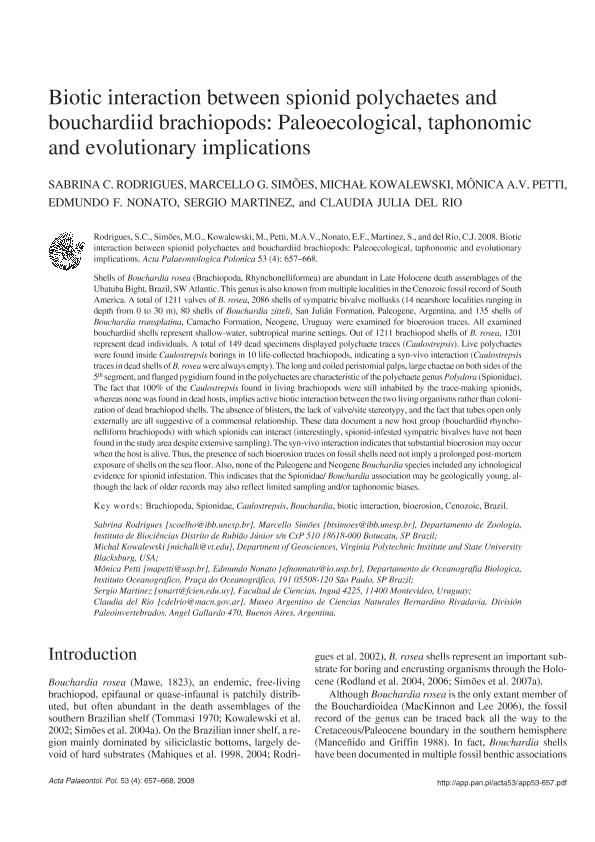Mostrar el registro sencillo del ítem
dc.contributor.author
Rodrigues, Sabrina C.
dc.contributor.author
Simões, Marcello G.
dc.contributor.author
Kowalewski, Michal
dc.contributor.author
Petti, Mônica A.V.
dc.contributor.author
Nonato, Edmundo F.
dc.contributor.author
Martinez, Sergio
dc.contributor.author
del Río, Claudia Julia

dc.date.available
2020-08-24T18:55:05Z
dc.date.issued
2008-12
dc.identifier.citation
Rodrigues, Sabrina C.; Simões, Marcello G.; Kowalewski, Michal; Petti, Mônica A.V.; Nonato, Edmundo F.; et al.; Biotic interaction between spionid polychaetes and bouchardiid brachiopods: Paleoecological, taphonomic and evolutionary implications; Polish Academy of Sciences. Institute of Paleobiology; Acta Palaeontologica Polonica; 53; 4; 12-2008; 657-668
dc.identifier.issn
1732-2421
dc.identifier.uri
http://hdl.handle.net/11336/112285
dc.description.abstract
Shells of Bouchardia rosea (Brachiopoda, Rhynchonelliformea) are abundant in Late Holocene death assemblages of the Ubatuba Bight, Brazil,SWAtlantic. This genus is also known frommultiple localities in the Cenozoic fossil record of South America. A total of 1211 valves of B. rosea, 2086 shells of sympatric bivalve mollusks (14 nearshore localities ranging indepth from 0 to 30 m), 80 shells of Bouchardia zitteli, San Julián Formation, Paleogene, Argentina, and 135 shells of Bouchardia transplatina, Camacho Formation, Neogene, Uruguay were examined for bioerosion traces. All examined bouchardiid shells represent shallow−water, subtropical marine settings. Out of 1211 brachiopod shells of B. rosea, 1201represent dead individuals. A total of 149 dead specimens displayed polychaete traces (Caulostrepsis). Live polychaetes were found inside Caulostrepsis borings in 10 life−collected brachiopods, indicating a syn−vivo interaction (Caulostrepsis traces in dead shells of B. rosea were always empty). The long and coiled peristomial palps, large chaetae on both sides of the5th segment, and flanged pygidium found in the polychaetes are characteristic of the polychaete genus Polydora (Spionidae). The fact that 100% of the Caulostrepsis found in living brachiopods were still inhabited by the trace−making spionids, whereas none was found in dead hosts, implies active biotic interaction between the two living organisms rather than colonization of dead brachiopod shells. The absence of blisters, the lack of valve/site stereotypy, and the fact that tubes open only externally are all suggestive of a commensal relationship. These data document a new host group (bouchardiid rhyncho−nelliform brachiopods) with which spionids can interact (interestingly, spionid−infested sympatric bivalves have not beenfound in the study area despite extensive sampling). The syn−vivo interaction indicates that substantial bioerosionmay occur when the host is alive. Thus, the presence of such bioerosion traces on fossil shells need not imply a prolonged post−mortem exposure of shells on the sea floor. Also, none of the Paleogene and Neogene Bouchardia species included any ichnological evidence for spionid infestation. This indicates that the Spionidae/ Bouchardia association may be geologically young, although the lack of older records may also reflect limited sampling and/or taphonomic biases.
dc.format
application/pdf
dc.language.iso
eng
dc.publisher
Polish Academy of Sciences. Institute of Paleobiology

dc.rights
info:eu-repo/semantics/openAccess
dc.rights.uri
https://creativecommons.org/licenses/by-nc-sa/2.5/ar/
dc.subject
BRACHIOPODS
dc.subject
CAENOZOIC
dc.subject
BRAZIL
dc.subject
ARGENTINA
dc.subject.classification
Paleontología

dc.subject.classification
Ciencias de la Tierra y relacionadas con el Medio Ambiente

dc.subject.classification
CIENCIAS NATURALES Y EXACTAS

dc.title
Biotic interaction between spionid polychaetes and bouchardiid brachiopods: Paleoecological, taphonomic and evolutionary implications
dc.type
info:eu-repo/semantics/article
dc.type
info:ar-repo/semantics/artículo
dc.type
info:eu-repo/semantics/publishedVersion
dc.date.updated
2020-07-20T18:18:55Z
dc.journal.volume
53
dc.journal.number
4
dc.journal.pagination
657-668
dc.journal.pais
Polonia

dc.journal.ciudad
Varsovia
dc.description.fil
Fil: Rodrigues, Sabrina C.. Instituto de Biociências; Brasil
dc.description.fil
Fil: Simões, Marcello G.. Instituto de Biociências; Brasil
dc.description.fil
Fil: Kowalewski, Michal. Virginia Polytechnic Institute; Estados Unidos
dc.description.fil
Fil: Petti, Mônica A.V.. Instituto Oceanografico; Brasil
dc.description.fil
Fil: Nonato, Edmundo F.. Instituto Oceanografico; Brasil
dc.description.fil
Fil: Martinez, Sergio. Universidad de la República. Facultad de Ciencias; Uruguay
dc.description.fil
Fil: del Río, Claudia Julia. Consejo Nacional de Investigaciones Científicas y Técnicas. Oficina de Coordinación Administrativa Parque Centenario. Museo Argentino de Ciencias Naturales "Bernardino Rivadavia"; Argentina
dc.journal.title
Acta Palaeontologica Polonica

dc.relation.alternativeid
info:eu-repo/semantics/altIdentifier/url/https://bioone.org/journals/acta-palaeontologica-polonica/volume-53/issue-4/app.2008.0410/Biotic-Interaction-between-Spionid-Polychaetes-and-Bouchardiid-Brachiopods--Paleoecological/10.4202/app.2008.0410.full
dc.relation.alternativeid
info:eu-repo/semantics/altIdentifier/doi/http://dx.doi.org/10.4202/app.2008.0410
Archivos asociados
